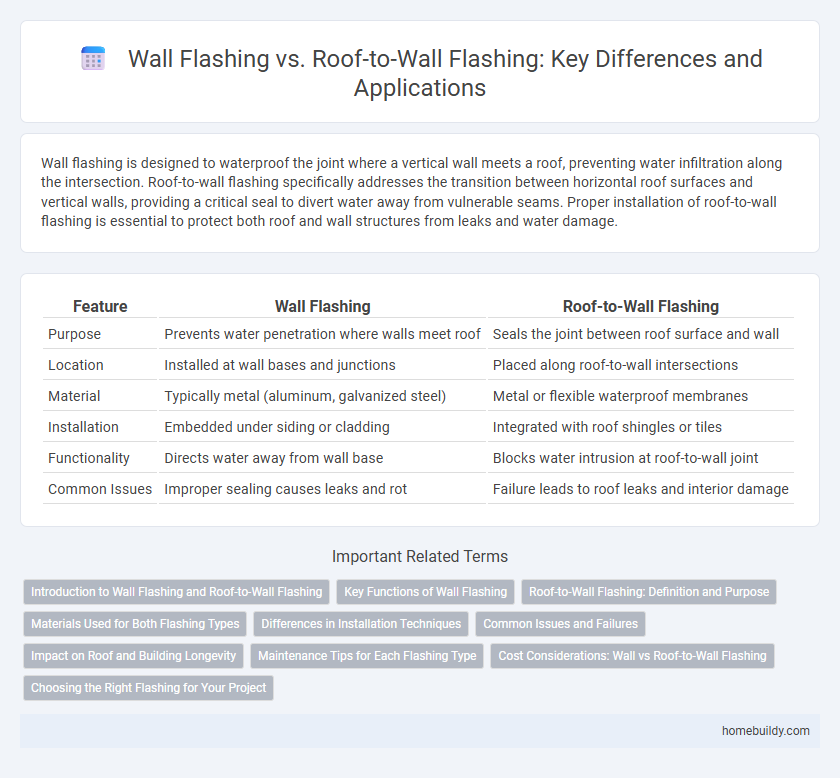Wall flashing is designed to waterproof the joint where a vertical wall meets a roof, preventing water infiltration along the intersection. Roof-to-wall flashing specifically addresses the transition between horizontal roof surfaces and vertical walls, providing a critical seal to divert water away from vulnerable seams. Proper installation of roof-to-wall flashing is essential to protect both roof and wall structures from leaks and water damage.
Table of Comparison
| Feature | Wall Flashing | Roof-to-Wall Flashing |
|---|---|---|
| Purpose | Prevents water penetration where walls meet roof | Seals the joint between roof surface and wall |
| Location | Installed at wall bases and junctions | Placed along roof-to-wall intersections |
| Material | Typically metal (aluminum, galvanized steel) | Metal or flexible waterproof membranes |
| Installation | Embedded under siding or cladding | Integrated with roof shingles or tiles |
| Functionality | Directs water away from wall base | Blocks water intrusion at roof-to-wall joint |
| Common Issues | Improper sealing causes leaks and rot | Failure leads to roof leaks and interior damage |
Introduction to Wall Flashing and Roof-to-Wall Flashing
Wall flashing directs water away from vertical surfaces to prevent leaks where the roof meets walls, typically installed at siding or brick junctions. Roof-to-wall flashing is a specific type of wall flashing designed to seal the intersection between horizontal roofing materials and vertical wall planes, ensuring a watertight barrier at these critical points. Proper installation of both wall flashing and roof-to-wall flashing is essential for protecting building structures from water infiltration and subsequent damage.
Key Functions of Wall Flashing
Wall flashing serves as a critical moisture barrier installed at the intersection between vertical walls and the roof surface, preventing water infiltration and protecting structural integrity. It directs water away from joints and vulnerable seams, minimizing the risk of leaks and damage to the building envelope. Unlike roof-to-wall flashing, which covers broader transition areas, wall flashing specifically ensures a watertight seal where walls meet roofing materials, enhancing long-term durability.
Roof-to-Wall Flashing: Definition and Purpose
Roof-to-wall flashing is a critical component designed to prevent water infiltration where the roof meets a vertical wall, creating a seamless barrier against moisture. This type of flashing directs rainwater away from the joint, protecting both the roof structure and the wall from potential water damage and leaks. Proper installation of roof-to-wall flashing ensures the durability and integrity of the building envelope by maintaining a watertight seal at this vulnerable intersection.
Materials Used for Both Flashing Types
Wall flashing typically utilizes materials such as aluminum, copper, or galvanized steel designed to protect vertical surfaces from water infiltration by directing moisture away from the wall structure. Roof-to-wall flashing often incorporates more flexible materials like rubberized asphalt or lead, combined with metal flashings to accommodate roof movement and ensure a watertight seal between the roof and adjoining walls. Both flashing types require durable, corrosion-resistant materials to withstand weather exposure and prevent leaks at critical junctions.
Differences in Installation Techniques
Wall flashing is installed by embedding it into the wall, typically under the siding or masonry, to direct water away from vertical surfaces. Roof-to-wall flashing requires integration at the roofline where the roof meets the wall, involving steps like installing step flashing and counter flashing to create layered water barriers. The key difference lies in roof-to-wall flashing's complex overlapping installation, which addresses water runoff from the roof plane onto the wall, whereas wall flashing primarily prevents water intrusion along vertical joints.
Common Issues and Failures
Wall flashing and roof-to-wall flashing often face common issues such as improper installation, poor sealing, and material deterioration, leading to water infiltration and damage. Inadequate overlap or gaps between the flashing and roofing materials can cause leaks, compromising the structural integrity of both the wall and roof. Regular inspection and maintenance are crucial to prevent failures like corrosion, cracking, and detachment, which are prevalent in these flashing types.
Impact on Roof and Building Longevity
Wall flashing directs water away from vertical surfaces, preventing moisture intrusion that can damage siding and structural integrity, thereby extending building longevity. Roof-to-wall flashing is specifically designed to seal the joint where a roof meets a wall, providing critical protection against leaks that can deteriorate roofing materials and underlying structures. Proper installation of both types ensures enhanced weather resistance, reducing maintenance costs and prolonging the lifespan of the entire roof assembly.
Maintenance Tips for Each Flashing Type
Wall flashing requires regular inspection to ensure that seals remain intact and prevent water infiltration behind siding or masonry. Roof-to-wall flashing demands close attention to junctions between the horizontal roof plane and vertical wall surfaces, especially during heavy rain or snow, to avoid leaks. Applying high-quality sealant and promptly replacing damaged flashing sections maintain the integrity of both types and extend their service life.
Cost Considerations: Wall vs Roof-to-Wall Flashing
Wall flashing typically incurs lower installation costs due to its simpler application along vertical surfaces, whereas roof-to-wall flashing demands more intricate detailing and higher labor expenses because it must effectively seal the intersection between sloped roofs and walls. Material costs vary, with roof-to-wall flashing often requiring more durable and flexible metals or membranes to withstand greater exposure to weather elements. Budget planning should account for these differences, as roof-to-wall flashing, while more costly upfront, provides enhanced protection against water infiltration at critical junctions.
Choosing the Right Flashing for Your Project
Wall flashing is designed to seal joints where vertical walls meet horizontal roofs, preventing water infiltration at these intersections. Roof-to-wall flashing combines both roof and wall flashing functions, providing enhanced protection by integrating materials to divert water away from the structure more effectively. Selecting the right flashing depends on roof design, wall materials, and local weather conditions to ensure long-lasting durability and optimal waterproofing performance.
Wall flashing vs roof-to-wall flashing Infographic

 homebuildy.com
homebuildy.com